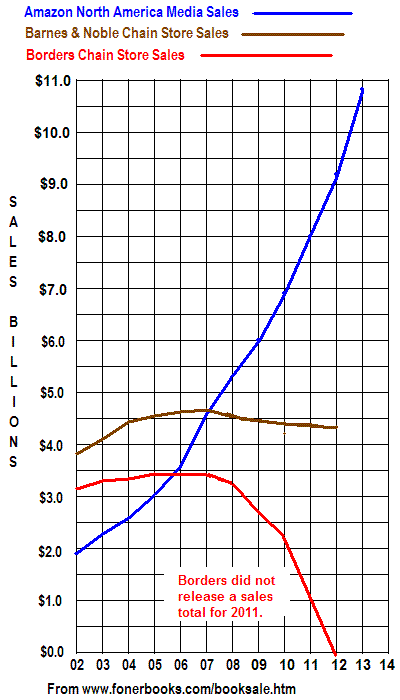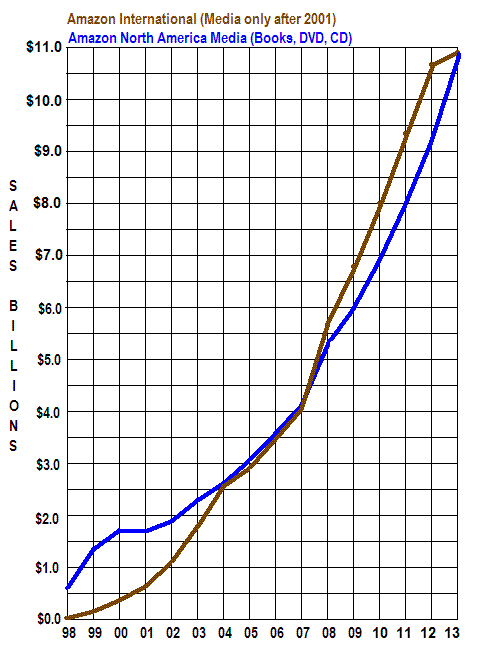
Book Sales Statistics
- Amazon Sales Rank
- Book Contract Negotiation
- Cover Design and Page Layout
- Print On Demand Cost and Profit
- Industry Book Sales
- SciFi eBook Publishing
- Query Letters and Book Proposals
- Indexing a Book in Word
- Order Book
Copyright 2016 by Morris Rosenthal
All Rights Reserved
Amazon, Barnes&Noble and Book Store Sales Numbers Annual Update.
The following current year information about book sales is taken from the annual reports, SEC filings and company press releases for the full year from Barnes&Noble, Borders, Amazon.com, and BN.com. International sales numbers for Borders and Amazon not included. Amazon is now the biggest book retailer, both in North America and overseas, Borders went into Chapter 11 bankruptcy in 2010 and announced on July 18. 2011 they would close their remaining stores, which were liquidated before the end of 2011. Full year 2013 sales statistics won't be available until Barnes & Noble reports, normally in May or June. Note that government reported sales for book retailers hit its lowest level since 2002, and adjusted for inflation (graph at bottom of page) bookstore sales (excluding online) are way down .
The 2014 update is now in progress with Amazon's 2013 report. B&N is behind on filing and struggling with structural issues.
|
I've dropped the table showing sales growth or loss percentages since the graphs cover it, well, graphically. |
The statistics show that book sales through retailers stayed way below trend in 2013, and overall bookstore sales have been treading water since 2003 according to the government (table below).Barnes and Noble pointed out years ago in a conference call that "most" of their business is in stable backlist sales, and their most valuable asset is their real estate. Barnes&Noble Nook peaked in 2012 and is now losing market share rapidly, as Amazon's Kindle has increased domination of the eBook market with multiple hardware updates a year, sold at break-even to encourage adoption.
Book sales from the US Census Bureau
| $Millions/Month | 2013 | 2012 | 2011 | 2010 | 2009 | 2008 | 2007 | 2006 | 2005 | 2004 | 2003 | 2002 |
| Jan | 1,879 | 1,782 | 1.960 | 2,178 | 2,214 | 2,301 | 2,222 | 2,225 | 2,075 | 2,148 | 2,056 | 1,973 |
| Feb | 879 | 876 | 962 | 962 | 985 | 1,157 | 1,040 | 1,101 | 1,086 | 1,108 | 992 | 1,001 |
| Mar | 806 | 812 | 881 | 962 | 961 | 1,026 | 1,029 | 1,092 | 1,101 | 1,073 | 926 | 1,009 |
| Apr | 757 | 802 | 798 | 871 | 929 | 1,005 | 931 | 987 | 997 | 1,023 | 976 | 968 |
| May | 937 | 963 | 936 | 1,032 | 1,071 | 1,159 | 1,135 | 1,176 | 1,020 | 1,112 | 1,109 | 1,118 |
| Jun | 829 | 916 | 904 | 1,040 | 1,058 | 1,077 | 1,162 | 1,238 | 1,154 | 1,206 | 1,182 | 1,046 |
| Jul | 816 | 862 | 869 | 1,025 | 1,056 | 1,124 | 1,221 | 1,135 | 1,214 | 1,172 | 1,130 | 1,038 |
| Aug | 1,928 | 2,018 | 2,154 | 2,183 | 2,337 | 2,435 | 2,330 | 2,142 | 2,219 | 2,119 | 2,142 | 1,799 |
| Sep | 1,291 | 1,221 | 1,353 | 1,448 | 1,548 | 1,481 | 1,579 | 1,555 | 1,553 | 1,560 | 1,574 | 1,491 |
| Oct | 797 | 807 | 772 | 949 | 975 | 1,032 | 1,129 | 1,055 | 1,064 | 1,069 | 1,047 | 998 |
| Nov | 818 | 854 | 823 | 1,030 | 979 | 1,044 | 1,227 | 1,143 | 1,150 | 1,088 | 1,037 | 1,060 |
| Dec | 1,491 | 1,449 | 1,982 | 1,938 | 2,029 | 2,179 | 2,134 | 2,256 | 2,199 | 2,065 | 1,949 | |
| Total (year) | 13,404 | 13,861 | 15,662 | 16,051 | 16,870 | 17,184 | 16,983 | 16,889 | 16,877 | 16,236 | 15,450 |
I updated all of the older data using the new Census Bureau database tool in April 2011, but they keep restating prior months so check the live data if you want to be exact. The government has a bad habit of changing historical numbers after the fact (after accounting for preliminary vs "final" data) but you can use the Internet Archive to view previous years and versions of this page with the original numbers. Note that the sales numbers are in constant dollars, the picture is grimmer when adjusted for inflation:

The $13.4 billion estimated by the US Census Bureau in their 2012 full year retail book sales statistics also includes the other non-book goods sold by those retailers, but doesn't include Amazon and other mail-order sellers. Amazon alone sold nearly $11.0 billion in media during 2013, so the trend for bookstores isn't pretty. Note that some large booksellers, such as Walmarts and supermarkets where a relatively limited selection of titles are sold, are not included in the Census Bureau statistics. Neither is Elhi (Elementary through High School) market for textbooks, which accounts for approximately $5 billion in sales per year, and book clubs. With specialty religion bookshops accounting for at least another billion in sales a year, and several billion dollars in professional books being sold through nontraditional channels, it's apparent that there isn't a huge slice of pie left over for the general indy booksellers by anybody's math.
Included in survey:
4512111 Book Stores, General
Establishments primarily engaged in retailing a general line of new books. These establishments may also sell stationery and related items, second-hand books, and magazines.
4512112 Specialty Book Stores
Establishments primarily engaged in retailing specialty books, such as general reference, religious, and professional books.
4512113 College Book Stores
Establishments primarily engaged in retailing textbooks, generally on the college level. Most of these establishments are located on or near college campuses, and some sell more apparel than books. These establishments may also offer second-hand textbooks. School book stores, other than college, are included in this industry.
| Year | 2000 | 2001 | 2002 | 2003 | 2004 | 2005 | 2006 | 2007 | 2008 | 2009 | 2010 |
2011
Q4 Only |
2012
Q4 Only |
2013
Q4 Only |
| % Total Item Sales | 6% | 13% | 17% | 22% | 26% | 28% | 28% | 28% | 28% | 30% | 32% | 36% | 39% | 39% |
| Year over year growth | N/A | 116% | 31% | 29% | 18% | 7% | 0% | 0% | 0% | 7% | 3% | N/A | N/A | N/A |
Amazon stopped reporting third party sales as a percentage of total unit sales in their 2011 10K report. Since that time, they have published the percentage of unit sales from third parties in the 4th quarter in press releases, as shown above.
In 2005, Amazon bought BookSurge LLC, an aggressive POD company whose performance had hitherto been limited by their lack of access to Amazon. They don't break out Booksurge in their annual report, and in 2009, rolled BookSurge into CreateSpace, another self publishing acquisition. Amazon stopped selling PDF ebooks through their International sites in 2005 and dropped the Lightning Source ebooks that made up most of their North American ebook sales in 2006. Amazon has also stopped drop shipping books from Ingram, a relationship that made their early claims to having the biggest selection in the world feasible. Google announced they would start selling ebooks in 2006 but didn't get around to it until 2011 with Google Play. Amazon's international media sales were greater than their North American media sales for a few years, but the two are converging again as growth overseas falters, due in part to European protection of bricks-and-mortar bookstores through price fixing.

